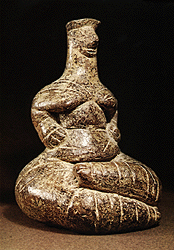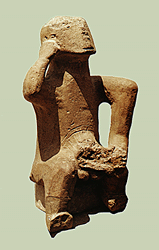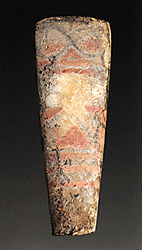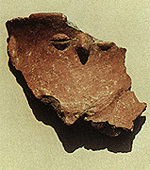 Anthropomorphic figurines present the greatest number and the richest forms in Neolithic plastic. They are encountered from the beginning of the Neolithic in clay, stone and more rarely in bone, sea-shell, silver and gold, and depict female and male figures. Their height ranged as a rule between 4 and 20 centimetres. |

 Figurines of the Early and the Middle Neolithic were naturalistic, with
their genders stressed. Female figurines have been assumed to symbolize
the goddess of fertility (mother-goddess). They were
represented standing, sitting, squatting, reclining, in stages of
pregnancy, giving birth or showing maternal affection. In some of them
individual traits were represented, with incisions or colour (old or hunched
women), a detail that enhances the view that they were portraits or represented
characteristic figures of Neolithic society. This is also confirmed by
male figurines of the Middle Neolithic with mongolian traits (Prodromos)
and in particular by the sitting figure of the "Thinker" (Karditsa). This
figurine of the Late Neolithic, which is 47,7 centimeters high and an
imitation of its counterparts from the Balkans, is a unique specimen of
large sculpture in Greece.
Figurines of the Early and the Middle Neolithic were naturalistic, with
their genders stressed. Female figurines have been assumed to symbolize
the goddess of fertility (mother-goddess). They were
represented standing, sitting, squatting, reclining, in stages of
pregnancy, giving birth or showing maternal affection. In some of them
individual traits were represented, with incisions or colour (old or hunched
women), a detail that enhances the view that they were portraits or represented
characteristic figures of Neolithic society. This is also confirmed by
male figurines of the Middle Neolithic with mongolian traits (Prodromos)
and in particular by the sitting figure of the "Thinker" (Karditsa). This
figurine of the Late Neolithic, which is 47,7 centimeters high and an
imitation of its counterparts from the Balkans, is a unique specimen of
large sculpture in Greece. |

During the Late and Final Neolithic schematization predominated, with the abstract rendition of human traits. Figurines were almost "plank-shaped", with flattened trunks, while the hands were represented by two horizontal bosses on the upper part of the body. Characteristic of the Late Neolithic were the "cruciform" figurines made of marble, on which anatomic details were emphasized with red colour. Finally, a specific class which dates to the Rachmani phase (Final Neolithic in Thessaly), are the "acroliths": Their body consisted of a clay cylinder, in which a marble triangular head was inset and whose traits were painted in red and black colour. Schematization and casual creation, but also the frequency with which they are encountered, suggests a symbolic meaning to their use. |

Complete schematization of the human form was rendered by ring idol figurines or pendants (amulets) of clay, stone, silver and gold. These appeared as isolated cases in the Late Neolithic but were much more widely disseminated -especially silver and gold ones- during the Final Neolithic. Known examples, 2-10 centimetres high, from Aravissos in Macedonia, Theopetra in Thessaly, Euripides Cave on Salamis, Diros in Mani, Amnissos on Crete, and those from a hoard discovered in the hands of illicit dealers in 1997, show that they were sewn on clothes (as documented in the famous cemetery of Varna in Bulgaria) or hung from the neck as amulets, the way the golden cross is today, which apart from its symbolic value, constituted the ultimate schematization of human form. |

Human form was also rendered in Neolithic art incised with simple deft lines on small pebbles, found in Sesklo and Magoula Karamoulrar in Thessaly, and depicted in relief on clay vases, as in the example from Nea Nikomedeia in Macedonia (Early Neolithic). |